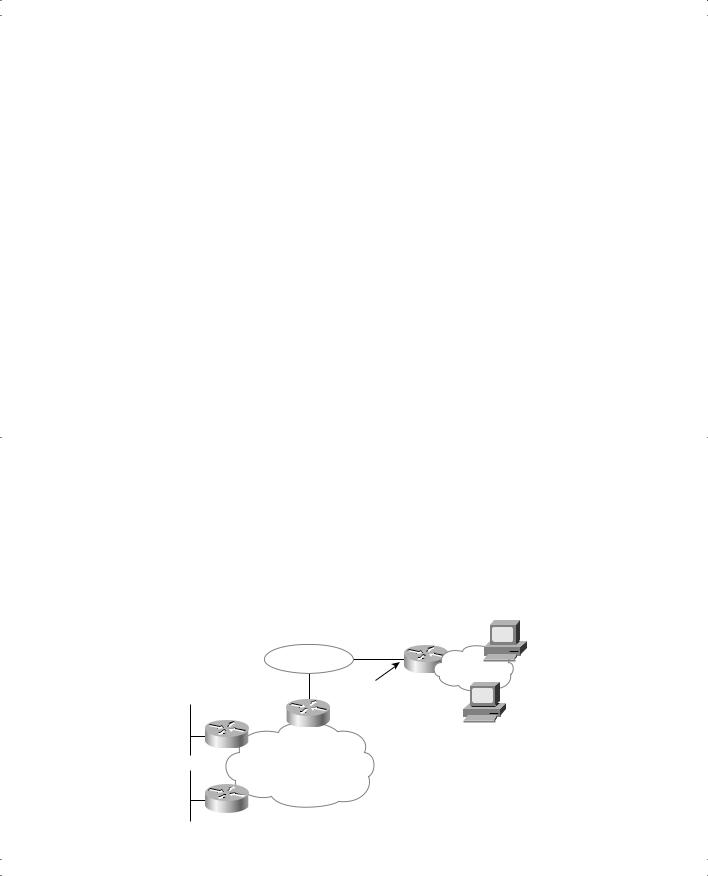
- •Warning and Disclaimer
- •Feedback Information
- •Trademark Acknowledgments
- •About the Author
- •About the Technical Reviewers
- •Dedication
- •Acknowledgments
- •Contents at a Glance
- •Contents
- •Icons Used in This Book
- •Command Syntax Conventions
- •Cisco’s Motivation: Certifying Partners
- •Format of the CCNA Exams
- •What’s on the CCNA Exams
- •ICND Exam Topics
- •Cross-Reference Between Exam Topics and Book Parts
- •CCNA Exam Topics
- •INTRO and ICND Course Outlines
- •Objectives and Methods
- •Book Features
- •How This Book Is Organized
- •Part I: LAN Switching
- •Part II: TCP/IP
- •Part III: Wide-Area Networks
- •Part IV: Network Security
- •Part V: Final Preparation
- •Part VI: Appendixes
- •How to Use These Books to Prepare for the CCNA Exam
- •For More Information
- •Part I: LAN Switching
- •“Do I Know This Already?” Quiz
- •Foundation Topics
- •Brief Review of LAN Switching
- •The Forward-Versus-Filter Decision
- •How Switches Learn MAC Addresses
- •Forwarding Unknown Unicasts and Broadcasts
- •LAN Switch Logic Summary
- •Basic Switch Operation
- •Foundation Summary
- •Spanning Tree Protocol
- •“Do I Know This Already?” Quiz
- •Foundation Topics
- •Spanning Tree Protocol
- •What IEEE 802.1d Spanning Tree Does
- •How Spanning Tree Works
- •Electing the Root and Discovering Root Ports and Designated Ports
- •Reacting to Changes in the Network
- •Spanning Tree Protocol Summary
- •Optional STP Features
- •EtherChannel
- •PortFast
- •Rapid Spanning Tree (IEEE 802.1w)
- •RSTP Link and Edge Types
- •RSTP Port States
- •RSTP Port Roles
- •RSTP Convergence
- •Edge-Type Behavior and PortFast
- •Link-Type Shared
- •Link-Type Point-to-Point
- •An Example of Speedy RSTP Convergence
- •Basic STP show Commands
- •Changing STP Port Costs and Bridge Priority
- •Foundation Summary
- •Foundation Summary
- •Virtual LANs and Trunking
- •“Do I Know This Already?” Quiz
- •Foundation Topics
- •Review of Virtual LAN Concepts
- •Trunking with ISL and 802.1Q
- •ISL and 802.1Q Compared
- •VLAN Trunking Protocol (VTP)
- •How VTP Works
- •VTP Pruning
- •Foundation Summary
- •Part II: TCP/IP
- •IP Addressing and Subnetting
- •“Do I Know This Already?” Quiz
- •Foundation Topics
- •IP Addressing Review
- •IP Subnetting
- •Analyzing and Interpreting IP Addresses and Subnets
- •Math Operations Used to Answer Subnetting Questions
- •Converting IP Addresses from Decimal to Binary and Back Again
- •The Boolean AND Operation
- •How Many Hosts and How Many Subnets?
- •What Is the Subnet Number, and What Are the IP Addresses in the Subnet?
- •Finding the Subnet Number
- •Finding the Subnet Broadcast Address
- •Finding the Range of Valid IP Addresses in a Subnet
- •Finding the Answers Without Using Binary
- •Easier Math with Easy Masks
- •Which Subnet Masks Meet the Stated Design Requirements?
- •What Are the Other Subnet Numbers?
- •Foundation Summary
- •“Do I Know This Already?” Quiz
- •Foundation Topics
- •Extended ping Command
- •Distance Vector Concepts
- •Distance Vector Loop-Avoidance Features
- •Route Poisoning
- •Split Horizon
- •Split Horizon with Poison Reverse
- •Hold-Down Timer
- •Triggered (Flash) Updates
- •RIP and IGRP
- •IGRP Metrics
- •Examination of RIP and IGRP debug and show Commands
- •Issues When Multiple Routes to the Same Subnet Exist
- •Administrative Distance
- •Foundation Summary
- •“Do I Know This Already?” Quiz
- •Foundation Topics
- •Link-State Routing Protocol and OSPF Concepts
- •Steady-State Operation
- •Loop Avoidance
- •Scaling OSPF Through Hierarchical Design
- •OSPF Areas
- •Stub Areas
- •Summary: Comparing Link-State and OSPF to Distance Vector Protocols
- •Balanced Hybrid Routing Protocol and EIGRP Concepts
- •EIGRP Loop Avoidance
- •EIGRP Summary
- •Foundation Summary
- •“Do I Know This Already?” Quiz
- •Foundation Topics
- •Route Summarization and Variable-Length Subnet Masks
- •Route Summarization Concepts
- •VLSM
- •Route Summarization Strategies
- •Sample “Best” Summary on Seville
- •Sample “Best” Summary on Yosemite
- •Classless Routing Protocols and Classless Routing
- •Classless and Classful Routing Protocols
- •Autosummarization
- •Classful and Classless Routing
- •Default Routes
- •Classless Routing
- •Foundation Summary
- •Advanced TCP/IP Topics
- •“Do I Know This Already?” Quiz
- •Foundation Topics
- •Scaling the IP Address Space for the Internet
- •CIDR
- •Private Addressing
- •Network Address Translation
- •Static NAT
- •Dynamic NAT
- •Overloading NAT with Port Address Translation (PAT)
- •Translating Overlapping Addresses
- •Miscellaneous TCP/IP Topics
- •Internet Control Message Protocol (ICMP)
- •ICMP Echo Request and Echo Reply
- •Destination Unreachable ICMP Message
- •Time Exceeded ICMP Message
- •Redirect ICMP Message
- •Secondary IP Addressing
- •FTP and TFTP
- •TFTP
- •MTU and Fragmentation
- •Foundation Summary
- •Part III: Wide-Area Networks
- •“Do I Know This Already?” Quiz
- •Foundation Topics
- •Review of WAN Basics
- •Physical Components of Point-to-Point Leased Lines
- •Data-Link Protocols for Point-to-Point Leased Lines
- •HDLC and PPP Compared
- •Looped Link Detection
- •Enhanced Error Detection
- •Authentication Over WAN Links
- •PAP and CHAP Authentication
- •Foundation Summary
- •“Do I Know This Already?” Quiz
- •Foundation Topics
- •ISDN Protocols and Design
- •Typical Uses of ISDN
- •ISDN Channels
- •ISDN Protocols
- •ISDN BRI Function Groups and Reference Points
- •ISDN PRI Function Groups and Reference Points
- •BRI and PRI Encoding and Framing
- •PRI Encoding
- •PRI Framing
- •BRI Framing and Encoding
- •DDR Step 1: Routing Packets Out the Interface to Be Dialed
- •DDR Step 2: Determining the Subset of the Packets That Trigger the Dialing Process
- •DDR Step 3: Dialing (Signaling)
- •DDR Step 4: Determining When the Connection Is Terminated
- •ISDN and DDR show and debug Commands
- •Multilink PPP
- •Foundation Summary
- •Frame Relay
- •“Do I Know This Already?” Quiz
- •Foundation Topics
- •Frame Relay Protocols
- •Frame Relay Standards
- •Virtual Circuits
- •LMI and Encapsulation Types
- •DLCI Addressing Details
- •Network Layer Concerns with Frame Relay
- •Layer 3 Addressing with Frame Relay
- •Frame Relay Layer 3 Addressing: One Subnet Containing All Frame Relay DTEs
- •Frame Relay Layer 3 Addressing: One Subnet Per VC
- •Frame Relay Layer 3 Addressing: Hybrid Approach
- •Broadcast Handling
- •Frame Relay Service Interworking
- •A Fully-Meshed Network with One IP Subnet
- •Frame Relay Address Mapping
- •A Partially-Meshed Network with One IP Subnet Per VC
- •A Partially-Meshed Network with Some Fully-Meshed Parts
- •Foundation Summary
- •Part IV: Network Security
- •IP Access Control List Security
- •“Do I Know This Already?” Quiz
- •Foundation Topics
- •Standard IP Access Control Lists
- •IP Standard ACL Concepts
- •Wildcard Masks
- •Standard IP ACL: Example 2
- •Extended IP Access Control Lists
- •Extended IP ACL Concepts
- •Extended IP Access Lists: Example 1
- •Extended IP Access Lists: Example 2
- •Miscellaneous ACL Topics
- •Named IP Access Lists
- •Controlling Telnet Access with ACLs
- •ACL Implementation Considerations
- •Foundation Summary
- •Part V: Final Preparation
- •Final Preparation
- •Suggestions for Final Preparation
- •Preparing for the Exam Experience
- •Final Lab Scenarios
- •Scenario 1
- •Scenario 1, Part A: Planning
- •Solutions to Scenario 1, Part A: Planning
- •Scenario 2
- •Scenario 2, Part A: Planning
- •Solutions to Scenario 2, Part A: Planning
- •Part VI: Appendixes
- •Glossary
- •Answers to the “Do I Know This Already?” Quizzes and Q&A Questions
- •Chapter 1
- •“Do I Know This Already?” Quiz
- •Chapter 2
- •“Do I Know This Already?” Quiz
- •Chapter 3
- •“Do I Know This Already?” Quiz
- •Chapter 4
- •“Do I Know This Already?” Quiz
- •Chapter 5
- •“Do I Know This Already?” Quiz
- •Chapter 6
- •“Do I Know This Already?” Quiz
- •Chapter 7
- •“Do I Know This Already?” Quiz
- •Chapter 8
- •“Do I Know This Already?” Quiz
- •Chapter 9
- •“Do I Know This Already?” Quiz
- •Chapter 10
- •“Do I Know This Already?” Quiz
- •Chapter 11
- •“Do I Know This Already?” Quiz
- •Chapter 12
- •“Do I Know This Already?” Quiz
- •Using the Simulation Software for the Hands-on Exercises
- •Accessing NetSim from the CD
- •Hands-on Exercises Available with NetSim
- •Scenarios
- •Labs
- •Listing of the Hands-on Exercises
- •How You Should Proceed with NetSim
- •Considerations When Using NetSim
- •Routing Protocol Overview
- •Comparing and Contrasting IP Routing Protocols
- •Routing Through the Internet with the Border Gateway Protocol
- •RIP Version 2
- •The Integrated IS-IS Link State Routing Protocol
- •Summary of Interior Routing Protocols
- •Numbering Ports (Interfaces)

238 Chapter 7: Advanced Routing Protocol Topics
Classful and Classless Routing
IP routing—the actual process of forwarding IP packets—can be considered either classful or classless. As mentioned in the preceding section, routing protocols also are considered either classful or classless. Classless routing protocols ignore Class A, B, and C rules, because they have much better information—the actual subnet masks sent with routing updates.
Similarly, IP routing is classless when the process of forwarding packets ignores class rules, and it is classful when routing must consider class rules when making a decision. However, the concepts behind classless and classful routing are totally independent of the routing protocol used and how it is configured. In fact, a router can use only static routes, and the concepts of classless and classful routing would still apply.
The choice of whether a router uses classful or classless routing determines how that router uses its default route. So, to fully understand what classless and classful routing really mean, you must first understand a little more about default routes. When a router needs to route a packet, and there is no route matching that packet’s destination in the routing table, the router discards the packet. Routers that have a default route can consider that packets that do not match a more specific route at least match the default route, so the packet is forwarded according to the default route, as opposed to being discarded. To appreciate the meaning of the terms classless routing and classful routing, you must first take a closer look at default routes in Cisco routers.
Default Routes
Default routes work best when only one path exists to a part of the network. In Figure 7-5, R1, R2, and R3 are connected to the rest of the network only through R1’s Token Ring interface. All three routers can forward packets to the rest of the network as long as the packets get to R1, which forwards them to Dist1.
Figure 7-5 Sample Network Using a Default Route
168.13.200.1
|
Dist1 |
|
168.13.1.0/24 |
|
Rest of Net |
|
168.13.1.101 |
168.13.2.0/24 |
R1 |
|
|
|
10.1.1.1 |
R2 |
168.13.100.1 |
168.13.100.0/24 |
Frame
Relay
168.13.3.0/24
R3

Classless Routing Protocols and Classless Routing 239
By coding a default route on R1 that points to router Dist1 in Figure 7-5, and by having R1 advertise the default to R2 and R3, default routing can be accomplished. (Chapter 5, “RIP, IGRP, and Static Route Concepts and Configuration,” covers the basics of how to configure static routes.) R1, R2, and R3 should not need specific routes to the subnets to the right of router Dist1. Examples 7-9 and 7-10, along with Figure 7-5, show an example of a default route on R1.
Example 7-9 R1 Static Default Route Configuration and Routing Table
R1(config)#ip route 0.0.0.0 0.0.0.0 168.13.1.101
R1#show ip route
Codes: C - connected, S - static, I - IGRP, R - RIP, M - mobile, B - BGP
D - EIGRP, EX - EIGRP external, O - OSPF, IA - OSPF inter area
N1 - OSPF NSSA external type 1, N2 - OSPF NSSA external type 2
E1 - OSPF external type 1, E2 - OSPF external type 2, E - EGP
i - IS-IS, L1 - IS-IS level-1, L2 - IS-IS level-2, ia - IS-IS inter area * - candidate default, U - per-user static route, o - ODR
P - periodic downloaded static route
Gateway of last resort is 168.13.1.101 to network 0.0.0.0
168.13.0.0/24 is subnetted, 4 subnets
C168.13.1.0 is directly connected, TokenRing0
R168.13.3.0 [120/1] via 168.13.100.3, 00:00:05, Serial0.1
R168.13.2.0 [120/1] via 168.13.100.2, 00:00:21, Serial0.1 C 168.13.100.0 is directly connected, Serial0.1
S* |
0.0.0.0/0 [1/0] via 168.13.1.101 |
R1# |
|
Example 7-10 R3: Nuances of the Successful Use of the Static Route on R1
R3#show ip route
Codes: C - connected, S - static, I - IGRP, R - RIP, M - mobile, B - BGP
D - EIGRP, EX - EIGRP external, O - OSPF, IA - OSPF inter area
N1 - OSPF NSSA external type 1, N2 - OSPF NSSA external type 2
E1 - OSPF external type 1, E2 - OSPF external type 2, E - EGP
i - IS-IS, L1 - IS-IS level-1, L2 - IS-IS level-2, ia - IS-IS inter area * - candidate default, U - per-user static route, o - ODR
P - periodic downloaded static route
Gateway of last resort is 168.13.100.1 to network 0.0.0.0
168.13.0.0/24 is subnetted, 4 subnets
R168.13.1.0 [120/1] via 168.13.100.1, 00:00:13, Serial0.1 C 168.13.3.0 is directly connected, Ethernet0
R168.13.2.0 [120/1] via 168.13.100.2, 00:00:06, Serial0.1 C 168.13.100.0 is directly connected, Serial0.1

240 Chapter 7: Advanced Routing Protocol Topics
R1 defines the default route with a static ip route command, with destination 0.0.0.0, mask 0.0.0.0. This route matches all destinations by convention. R1 advertises this default route to R2 and R3, as shown in the output of the show ip route command on R3 in Example 7-10.
Different routing protocols advertise default routes in a couple of different ways. As an example, this chapter covers how RIP handles the default in this network. R1 lists a static route to 0.0.0.0, mask 0.0.0.0, with next hop 168.13.1.101—essentially, the same information that was entered in the ip route 0.0.0.0 0.0.0.0 168.13.1.101 global configuration command. RIP advertises this default to R2 and R3, which, instead of listing 0.0.0.0 as a network in their routing tables, list the phrase that begins “Gateway of last resort”. When no other route is matched, the gateway of last resort can be used to forward the packet. In other words, it is the default route.
Another style of configuration for the default route uses the ip default-network command.
This command is used most typically when you want to reach other Class A, B, or C networks by default but all the subnets of your own network are expected to be in your own routing tables. For example, imagine that the cloud next to Dist1 in Figure 7-5 has subnets of network 10.0.0.0 in it as well as other networks. (Dist1 could be an ISP router.) Dist1 already advertises a route to network 10.0.0.0 to R1, so R1 decides to use the same routing information for that route as its default route. To do that instead of using the ip route 0.0.0.0 0.0.0.0 168.13.1.101 command, the ip default-network 10.0.0.0 command is used on R1. R1 uses its route to network 10.0.0.0 as its default and advertises this route as a default route to other routers. Examples 7-11 and 7-12 show several details about R1 and R3.
Example 7-11 R1’s Use of the ip default-network Command
R1#configure terminal
R1(config)#ip default-network 10.0.0.0
R1(config)#exit
R1#show ip route
Codes: C - connected, S - static, I - IGRP, R - RIP, M - mobile, B - BGP
D - EIGRP, EX - EIGRP external, O - OSPF, IA - OSPF inter area
N1 - OSPF NSSA external type 1, N2 - OSPF NSSA external type 2
E1 - OSPF external type 1, E2 - OSPF external type 2, E - EGP
i - IS-IS, L1 - IS-IS level-1, L2 - IS-IS level-2, ia - IS-IS inter area * - candidate default, U - per-user static route, o - ODR
P - periodic downloaded static route
Gateway of last resort is 168.13.1.101 to network 10.0.0.0
168.13.0.0/24 is subnetted, 5 subnets
R168.13.200.0 [120/1] via 168.13.1.101, 00:00:12, TokenRing0 C 168.13.1.0 is directly connected, TokenRing0
R168.13.3.0 [120/1] via 168.13.100.3, 00:00:00, Serial0.1
R168.13.2.0 [120/1] via 168.13.100.2, 00:00:00, Serial0.1
C168.13.100.0 is directly connected, Serial0.1
R* |
10.0.0.0/8 [120/1] via 168.13.1.101, 00:00:12, TokenRing0 |
R1# |
|

Classless Routing Protocols and Classless Routing 241
Example 7-12 R3 Routing Table and trace Command Samples
R3#show ip route
Codes: C - connected, S - static, I - IGRP, R - RIP, M - mobile, B - BGP
D - EIGRP, EX - EIGRP external, O - OSPF, IA - OSPF inter area
N1 - OSPF NSSA external type 1, N2 - OSPF NSSA external type 2
E1 - OSPF external type 1, E2 - OSPF external type 2, E - EGP
i - IS-IS, L1 - IS-IS level-1, L2 - IS-IS level-2, ia - IS-IS inter area * - candidate default, U - per-user static route, o - ODR
P - periodic downloaded static route
Gateway of last resort is 168.13.100.1 to network 0.0.0.0
168.13.0.0/24 is subnetted, 5 subnets
R168.13.200.0 [120/2] via 168.13.100.1, 00:00:26, Serial0.1
R168.13.1.0 [120/1] via 168.13.100.1, 00:00:26, Serial0.1
C168.13.3.0 is directly connected, Ethernet0
R168.13.2.0 [120/1] via 168.13.100.2, 00:00:18, Serial0.1 C 168.13.100.0 is directly connected, Serial0.1
R10.0.0.0/8 [120/2] via 168.13.100.1, 00:00:26, Serial0.1
R* 0.0.0.0/0 [120/2] via 168.13.100.1, 00:00:26, Serial0.1
R3#trace 168.13.222.2
Type escape sequence to abort.
Tracing the route to 168.13.222.2
1 168.13.100.1 68 msec 56 msec 52 msec
2 168.13.1.101 52 msec 56 msec 52 msec R3#trace 10.1.1.1
Type escape sequence to abort.
Tracing the route to 10.1.1.1
1 168.13.100.1 68 msec 56 msec 52 msec
2 168.13.1.101 48 msec 56 msec 52 msec R3#
Both R1 and R3 have default routes, but they are shown differently in their respective routing tables. R1 shows a route to network 10.0.0.0 with an *, meaning that it is a candidate to be the default route. In R3, 0.0.0.0 shows up in the routing table as the candidate default route. R3 shows this information differently because RIP advertises default routes using network number 0.0.0.0. If IGRP or EIGRP were in use, there would be no route to 0.0.0.0 on R3, and network 10.0.0.0 would be the candidate default route. That’s because IGRP and EIGRP would flag 10.0.0.0 as a candidate default route in their routing updates rather than advertise the special case of 0.0.0.0. The RIP protocol simply uses a different convention for how to advertise a default route.
